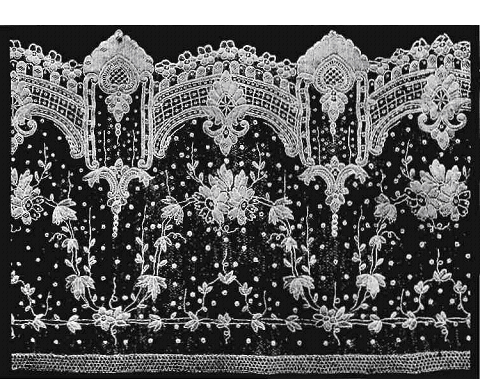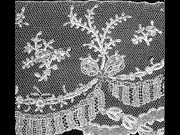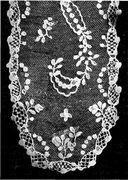ALENCON LACE
This, the most elaborate needle-point lace which has ever been produced in France, was first made in about 1665. Royal edicts, forbidding the wearing of Spanish and Italian laces, having been ineffectual in inducing the nobles of Louis XIV.'s extravagant court to wear the inferior laces produced by France, the king's ministers determined to improve the French laces, and thus keep in the country the enormous sums spent on Italian and Flemish ruffles.

The Venetian instructors who were appointed found intelligent pupils in the French lace-makers, who had been accustomed to make twisted and plaited thread laces; and to imitate the old Point Coupe of Italy, and when their prejudice was overcome, they became expert makers of the new fabric. It was difficult, however, to teach the lace-makers of Alencon to exactly imitate the Venetian stitches ; although until 1678 Alencon point strongly resembled Spanish and Venetian points, and is called Point de France, the designs and stitches being the same, and the ground in each case consisting of brides or connecting bars, either plain or ornamented : after that date a change is apparent in the lace made at Alencon, and it acquires characteristics of its own, and has its distinctive title.
Point d'Alencon was called a "winter" lace, on account of its being of a thick and firm make. This firmness is due to the cordonnet, and to this we owe the excellent preservation in which the lace is usually found, being far superior in this particular to Brussels point. The cordonnet in Alencon lace made in France is padded with horsehair ; occasionally specimens are found which have had the padding withdrawn, doubtless because of its tendency to shrink and draw up when washed. In Alencon lace, or Argentella, as it is called when made in Italy, the cordonnet is flat.

It was during the reigns of Louis XIV. and Louis XV. that Alencon was at the height of its glory. The most extravagant prices were paid for the lace ; not only were articles of clothing trimmed with it, but the beautiful fabric was used as bed furniture, valances, trimmings for bath covers, and bed spreads. Altars in the churches were hung with it, surplices of the priests trimmed with it, and the king gave away to his court favourites cravats, ruffles, and complete robes. Before the Revolution in 1794, and before the revocation of the Edict of Nantes, when France lost many of her most skilled workers, the annual value of the manufacture was estimated to be 12,000,000 livres. Work-people earned at this time 3 sous and upwards per day.

During the Revolution the Alencon lace factory became almost extinct, and many of the workers were killed on account of their connection with the hated aristocracy, as caterers to the luxury of the age. Others fled from the country so that it was with difficulty that sufficient workers could be found to carry out the lavish orders of Napoleon I., for the emperor saw prosperity to France in the revival of the lace industry. One of his gifts to Marie Louise was bed furniture of rich lace ; tester, coverlet, pillow cases and edgings for sheets were all made of the finest Alencons, the Royal arms on elaborate escutcheons being worked on a ground of Vrai or needle-point reseau, powdered over with bees, the Napoleonic cypher.
The Alencon lace factory fell with the empire. Many of the old workers died, and no young ones were trained to take their places. The Duchesse d'Angouleme tried to revive the industry, but her own handsome orders and those of her personal friends alone could not coax it back to prosperity. In 1830 there were only two or three hundred lace-workers employed.
Ten years iater the old women were gathered together and another effort was made. At the Exhibition of 1851 a few specimens were shown, and in 1856 large orders were given for the layette of the Prince Imperial. The coverlet of his little bed was of Alencon lace. The christening robe, mantle and head dress, and the three baskets were all trimmed with the beautiful point. Twelve dozen embroidered frocks were profusely trimmed with the lace, as were also the nurses' aprons.
In 1859 the most costly work ever executed at Alencon was exhibited. This was a dress valued at 200,000 francs, which was purchased by the Emperor Napoleon III. for the Empress.
It is helpful in judging Alencon point to know something of the dates of certain patterns, none of which are as fine as those used for Argentan point.

Like the designs of laces made at other factories, Alencon patterns will be found to correspond with the style of decoration in the houses and furniture of each successive period. For some time after the death of Colbert, the designs were chiefly flowing and undulating, showing that Venetian influence was not yet entirely shaken off. It is at this period that small figures and heads are sometimes introduced into the pattern. The eighteenth century patterns show garlands, while escutcheons or lozenges of finer ground appear just as the painted medallions of Boucher were inserted in the panels of the salons of the time.
Then, when in furniture the ornate legs of tables and chairs gave place to stiffer and more upright designs, the lace patterns became more rigid and angular. In Louis XVI.'s reign the reseau or ground was sewn over with spots, tears, sprigs or insects, and a narrow pattern used as border. The seme's or powderings continued during the Empire period, and they are still occasionally used in conjunction with designs from real flowers now in vogue. At present the finest modern Alencon Point is made at Bayeux, and at the Royal lace factory at Burano, near Venice. It was of Alencon lace that the beautiful wedding veil of Princess Helene of France, who in 1895 married the Due d'Aosta, was made. On the groundwork, which was the Vrai reseau or net made with the needle-point, was a floral design. Medallions in the centre enclosed the armorial bearings of the bridegroom surmounted by the Cross of Savoy, the Fleur de Lys, and the arms of France. This veil was of an unusually large size, being no less than fourteen feet long.
Modern Alencon lace ranks as fifth in value compared with other laces. It was so placed by the Commissioners at the Great Exhibition in 1851, Brussels, Mechlin, Valenciennes, and Lille taking rank above it.
Further Readings
Why Alencon was chosen by Colbert in the 17th century ?
Place to visit
Musée des Beaux Arts et de la Dentelle d'Alencon
